It looks like you're using an Ad Blocker.
Please white-list or disable AboveTopSecret.com in your ad-blocking tool.
Thank you.
Some features of ATS will be disabled while you continue to use an ad-blocker.
share:
originally posted by: bluesfreak
Hey Harte , I wasn’t trying to be a smart a** or shut anyone down by saying I work on machines, it’s the very reason some of these AE objects interest me! Im not trying to discredit academia or anything either, there is just some large scale work that really ask some questions.
I agree with what you have said about jigs, and being intrinsic to the work as a given.
However regarding these boxes being discussed ;you must agree show the resultant edges left by a saw blade larger than the boxes themselves it’s surely staring you in the face. As a former ME, me and you both know you could make this box on a mill using, say, aluminium for instance , surely? You know what you’d have to do to replicate the geometry. If you look at these boxes as a milling machine operator all those resultant edges and geometric symmetry seem to look machined to me . I don’t have any answers , I just don’t know!
If it WAS the case that they could machine it somehow with large rotating saws etc doesn’t that just make them even cleverer than we thought?! Which surely must be a good thing for Egyptology?
Am I missing something?!?!?!! - a reply to: Harte
We have all kinds here. Glad you're a machinist - that's a fine career - better than mine was IMO. But some people here actually make stone tools by hand, and some are stonemasons, etc. You and I have less to say about the matter when you look at it that way.
I'm of the opinion you can do this with pounders and smoothing stones, if you know what you're doing. And certainly with iron hand tools.
In any case it would have to be smoothed out by hand even if it was sawn - even with power saws - since the surfaces show no saw marks that I can see and saws leave marks, as do chisels.
Harte
edit on 11/14/2018 by Harte because: of the wonderful things he does!
a reply to: Harte
I got to the point I could make fairly good stone tools especially Clovis, some of the common Mayan ones and most of the tools used in Cyprus during the Pre-Pottery Neolithic A era. However, I only worked masonry for about 20 hours in Yucatan, Rapa Nui, Cyprus and a bit in Egypt - very hard work and I lack I the shoulder, elbow and wrist strength to be effective at it (the curse of a youth misspent on long distance running). I did view one artist in Mexico making a nearly perfect round limestone ball - 3/4 meter in size - in a few days using stones - absolutely amazing how he did it - of course he used newly cut limestone which is much easier to work, and he was an expert and had been doing so for thirty years his specialty was to make replace stones for the Mayan sites around Palenque.
I got to the point I could make fairly good stone tools especially Clovis, some of the common Mayan ones and most of the tools used in Cyprus during the Pre-Pottery Neolithic A era. However, I only worked masonry for about 20 hours in Yucatan, Rapa Nui, Cyprus and a bit in Egypt - very hard work and I lack I the shoulder, elbow and wrist strength to be effective at it (the curse of a youth misspent on long distance running). I did view one artist in Mexico making a nearly perfect round limestone ball - 3/4 meter in size - in a few days using stones - absolutely amazing how he did it - of course he used newly cut limestone which is much easier to work, and he was an expert and had been doing so for thirty years his specialty was to make replace stones for the Mayan sites around Palenque.
originally posted by: Harte
a reply to: Hanslune
And that was in marble.
Harte
The greatest piece I've seen was the Laccoon - made of marble by three experts
files.abovetopsecret.com...
The Laocoon statue, standing some 8 feet in height, is made from seven interlocking pieces of white marble. Its exact date of creation is uncertain, although - in line with several inscriptions found in Rhodes dating Hagesander and Athenedoros to some time after 42 BCE - experts now believe that it was sculpted between 42-20 BCE. More importantly, it is not known for certain whether it is an original Roman sculpture or a copy of an earlier Greek sculpture. That said, experts now believe that its three sculptors - Hagesander, Athenodoros and Polydorus - were highly-skilled copyists who specialized in producing replicas of original Greek figures for wealthy Roman customers. Thus, in all probability, the Vatican Laocoon is a copy of a Greek Hellenistic bronze - almost certainly from the Pergamon School, see similar drama, straining muscles and contorted faces in the Great Altar of Zeus (c.180 BCE, Pergamon, Turkey).
Now of course they had iron chisels but much of it had to be made with abrasives - the same way people had been doing it for thousands of years.
If the AE had the technology to divide, cut and face stones as they, or who ever came before them did,
substantial energy was required.
If you have that, well then why not a sandblasting or water blasting machine that could take a rough accurately flat surface to sheen?
substantial energy was required.
If you have that, well then why not a sandblasting or water blasting machine that could take a rough accurately flat surface to sheen?
originally posted by: charlyv
If the AE had the technology to divide, cut and face stones as they, or who ever came before them did,
substantial energy was required.
If you have that, well then why not a sandblasting or water blasting machine that could take a rough accurately flat surface to sheen?
If they had that type of technology why would they have gone to war armed with bronze and copper weapons?
basically the main technical problem boils down to the usage of iron in ancient egypt..scholars say it wasn't used till the greeks had their first
settlements eg Naukratis a town in the western egypian delta.
We also know of meteorite iron but very rarely..
I'd rather believe that we hav lost all traces of ancient egyptian iron than the more stupid ancient alien nonsense or other fringe ideas.
We also know of meteorite iron but very rarely..
I'd rather believe that we hav lost all traces of ancient egyptian iron than the more stupid ancient alien nonsense or other fringe ideas.
originally posted by: anti72
basically the main technical problem boils down to the usage of iron in ancient egypt..scholars say it wasn't used till the greeks had their first settlements eg Naukratis a town in the western egypian delta.
We also know of meteorite iron but very rarely..
I'd rather believe that we hav lost all traces of ancient egyptian iron than the more stupid ancient alien nonsense or other fringe ideas.
It certainly possible they had iron which was then used up but iron production causes a real mess and such facilities have not been located and the known iron mines appear to have been worked later. Undetected mines or imported iron remains a possibility. Rock vs rock still remains viable however.
Interesting note on the use of iron:
Iron metal is singularly scarce in collections of Egyptian antiquities. Bronze remained the primary material there until the conquest by Neo-Assyrian Empire in 671 BC. The explanation of this would seem to lie in the fact that the relics are in most cases the paraphernalia of tombs, the funeral vessels and vases, and iron being considered an impure metal by the ancient Egyptians it was never used in their manufacture of these or for any religious purposes. It was attributed to Seth, the spirit of evil who according to Egyptian tradition governed the central deserts of Africa. In the Black Pyramid of Abusir, dating before 2000 BC, Gaston Maspero found some pieces of iron. In the funeral text of Pepi I, the metal is mentioned. A sword bearing the name of pharaoh Merneptah as well as a battle axe with an iron blade and gold-decorated bronze shaft were both found in the excavation of Ugarit.
en.wikipedia.org...
originally posted by: bluesfreak
Can’t figure out why I can’t post pics at moment but will add things that piqued my interest when I figure it out. Thanks again, very appreciated.a reply to: jeep3r
Here's a short tutorial on how to upload images on ATS:

a reply to: Hanslune
yes, interesting, I read something like this before..iron being an impure material for their religious porposes, attributed with Seth.
also Vyse found a piece of an iron plate in the s shaft of the kings chamber in the GP..
www.catchpenny.org...
of course the imore nteresting question would be, how the could have forged iron above 1500 degrees as it stays brittle beyond.
yes, interesting, I read something like this before..iron being an impure material for their religious porposes, attributed with Seth.
also Vyse found a piece of an iron plate in the s shaft of the kings chamber in the GP..
www.catchpenny.org...
This is to certify, that the piece of iron found by me near the mouth of the air-passage, in the southern side of the Great Pyramid at Gizeh, on Friday, May 26th, was taken out by me from an inner joint, after having removed by blasting the two outer tiers of the stones of the present surface of the Pyramid; and that no joint or opening of any sort was connected with the above-mentioned joint, by which the iron could have been placed in it after the original building of the Pyramid. I also shewed the exact point to Mr. Perring, on Saturday, June 24th. (Vyse, Pyramids of Gizeh, I, p. 276)
Flinders Petrie wrote of the plate in The Pyramids and Temples of Gizeh (1883):
That sheet iron was employed, we know, from the fragment found by Howard Vyse in the masonry of the south air channel, and though some doubt has been thrown on the piece, merely from its rarity, yet the vouchers for it are very precise, and it has a cast of a nummulite on the rust of it, proving it to have been buried for ages beside a block of nummulitic limestone, and therefore to be certainly ancient. No reasonable doubt can therefore exist about its being really a genuine piece used by the pyramid masons, and probably such pieces were required to prevent crowbars biting into the stones, and to ease the actions of the rollers. (p. 212-13)
of course the imore nteresting question would be, how the could have forged iron above 1500 degrees as it stays brittle beyond.
edit on
15-11-2018 by anti72 because: (no reason given)
Hi Harte,
I know you are of the opinion that this could be done with stone pounders and possibly with iron tools, I completely respect your opinion, but I really must peacefully disagree .
The image below is the box seen from the bottom.
These are in my opinion resultant edges from a blade larger than the box.

I know the term ’accuracy’ can get people riled on here, but from an engineering point of view, that box/these boxes show an unusual degree of geometric symmetry, and the to me the internal recesses aren’t explained by the methods we know of.
It really would have taken an age to even begin to saw out even a 1m cube (6 sides)of granite from the bedrock at the rate we’ve seen , which is ,at best 3mm per day from the video we’ve seen. SOMETHING doesn’t add up here, do you agree ?
I know that time was a factor on their side if you like, but it if you do the maths on a 1m block, it seems crazy!
a reply to: Harte
I know you are of the opinion that this could be done with stone pounders and possibly with iron tools, I completely respect your opinion, but I really must peacefully disagree .
The image below is the box seen from the bottom.
These are in my opinion resultant edges from a blade larger than the box.

I know the term ’accuracy’ can get people riled on here, but from an engineering point of view, that box/these boxes show an unusual degree of geometric symmetry, and the to me the internal recesses aren’t explained by the methods we know of.
It really would have taken an age to even begin to saw out even a 1m cube (6 sides)of granite from the bedrock at the rate we’ve seen , which is ,at best 3mm per day from the video we’ve seen. SOMETHING doesn’t add up here, do you agree ?
I know that time was a factor on their side if you like, but it if you do the maths on a 1m block, it seems crazy!
a reply to: Harte
originally posted by: bluesfreak
Hi Harte,
I know you are of the opinion that this could be done with stone pounders and possibly with iron tools, I completely respect your opinion, but I really must peacefully disagree .
The image below is the box seen from the bottom.
These are in my opinion resultant edges from a blade larger than the box.
I know the term ’accuracy’ can get people riled on here, but from an engineering point of view, that box/these boxes show an unusual degree of geometric symmetry, and the to me the internal recesses aren’t explained by the methods we know of.
It really would have taken an age to even begin to saw out even a 1m cube (6 sides)of granite from the bedrock at the rate we’ve seen , which is ,at best 3mm per day from the video we’ve seen. SOMETHING doesn’t add up here, do you agree ?
I know that time was a factor on their side if you like, but it if you do the maths on a 1m block, it seems crazy!
EDIT: if you look at the bottom face of this item, you will notice that to left side of that face on our picture ,there are small ‘depressed’ sections - portions that are natural recesses(gaps) inside the granite block: when a blade is passed across these, they remain BELOW the surface that has been created by the cut, untouched by the blade or cutter.
This base face didn’t need to be polished either, as it was never intended to be seen, this is the face that , to me as a machinist I would like to inspect for tooling traces . I guess it puts an end to Foresters statement that these blades were polishing AS they cut.
.....And don’t get me started on the 3face cutting of the piece on the right of this picture!!!
a reply to: Harte
originally posted by: bluesfreak
Hi Harte,
I know you are of the opinion that this could be done with stone pounders and possibly with iron tools, I completely respect your opinion, but I really must peacefully disagree .
The image below is the box seen from the bottom.
These are in my opinion resultant edges from a blade larger than the box.
I know the term ’accuracy’ can get people riled on here, but from an engineering point of view, that box/these boxes show an unusual degree of geometric symmetry, and the to me the internal recesses aren’t explained by the methods we know of.
Same method used for hollowing out sarcophagi.
originally posted by: bluesfreakIt really would have taken an age to even begin to saw out even a 1m cube (6 sides)of granite from the bedrock at the rate we’ve seen , which is ,at best 3mm per day from the video we’ve seen. SOMETHING doesn’t add up here, do you agree ?
Sawing the cube out would take far longer than pounding it out and smoothing it with chisels then smaller pounders then smoothing stones.
You would need to explain the plethora of similar carved boxes that were shown in a previous post. With not a single trace of any "high tech" stone working equipment as relics, art or in their writings, tht's a very long row to hoe.
Harte
edit on 11/17/2018 by Harte because: of the wonderful things he does!
My apologies for using the ‘D’ word on here ( Dunn) but unfortunately he is talking my language in engineering terms:
Below is a piece of stone from Abu Rawash, that clearly shows a large circular saw did the cutting.
The stone does not lie here. Dunn also shows the correct method for determining the size of the circular blade used by using an equation that gives you the diameter by using 2 points on the circular striations made by the tool. I myself have used this calculation on numerous occasions in the workshop to determine radius. What Dunn shows is correct.
The stone also shows the feed rate of the tool in relation to modern day measurements in mm.
This tool sliced into the stone at just under 1mm per revolution of the (large) circular saw blade.

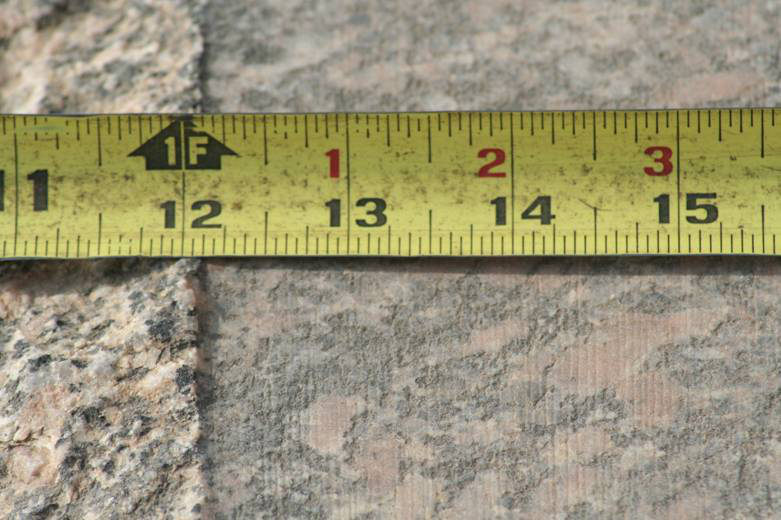
I see these striations everyday working on a milling machine where rotating circular cutters are passed over various materials, the tool will leave its signature .
I can’t read hieroglyphs , but I can read these, it’s part of my job, and whatever you opinions on Dunn and the ‘fringe’ his method here is correct.
a reply to: Harte
Below is a piece of stone from Abu Rawash, that clearly shows a large circular saw did the cutting.
The stone does not lie here. Dunn also shows the correct method for determining the size of the circular blade used by using an equation that gives you the diameter by using 2 points on the circular striations made by the tool. I myself have used this calculation on numerous occasions in the workshop to determine radius. What Dunn shows is correct.
The stone also shows the feed rate of the tool in relation to modern day measurements in mm.
This tool sliced into the stone at just under 1mm per revolution of the (large) circular saw blade.


I see these striations everyday working on a milling machine where rotating circular cutters are passed over various materials, the tool will leave its signature .
I can’t read hieroglyphs , but I can read these, it’s part of my job, and whatever you opinions on Dunn and the ‘fringe’ his method here is correct.
a reply to: Harte
You didn't notice people saying circular blades weren't out of the picture?
Hard to do feed rate on a cut made with sand. The striations aren't made by the blade and the sand is free to roam all over the cut. So Dunn is full of it on that, but the circular blade is certainly a possibility.
It's well within the AE's capabilities.
Harte
ETA: Upon closer examination, it seems that the striations aren't curved like the termination of the cut is.
Hard to do feed rate on a cut made with sand. The striations aren't made by the blade and the sand is free to roam all over the cut. So Dunn is full of it on that, but the circular blade is certainly a possibility.
It's well within the AE's capabilities.
Harte
ETA: Upon closer examination, it seems that the striations aren't curved like the termination of the cut is.
edit on 11/18/2018 by Harte
because: of the wonderful things he does!
Surely if the sand was “free to roam” throughout the cutting process, then we would see a far rougher looking cut with abrasive scratchy
striations al over it, and certainly inbetween the feed rate evidence we see here.
I also agree that circular saws were not beyond their capability, humans have always come to the conclusion “ why don’t we just make a bigger one” so in my mind the AE certainly could have thought on this scale in a production sense.
There are no AE artwork of these objects but yet the evidence is there. Perhaps that’s why there were more of the stone boxes like on Elephantine Island, because they had the sawing capability to ‘knock them out’ as we say.
I’d really like to examine that stone of Dunn’s at Abu Ghirab and look at the striations it’s a fascinating piece to me.
This cut looks too clean on the surface to have had abrasives flying about between the blade and material.
How are you so sure you are not looking at feed rate?
In the machining world, these striations indicate a ‘power feed’ fingerprint. They are VERY regular, perhaps too regular for two guys with a copper saw and sand taking an absolute age at 3mm per day to hack through the piece.
They could surely have spun a circular blade at high rpm, the AE had gears didn’t they?
Cairo Museum :
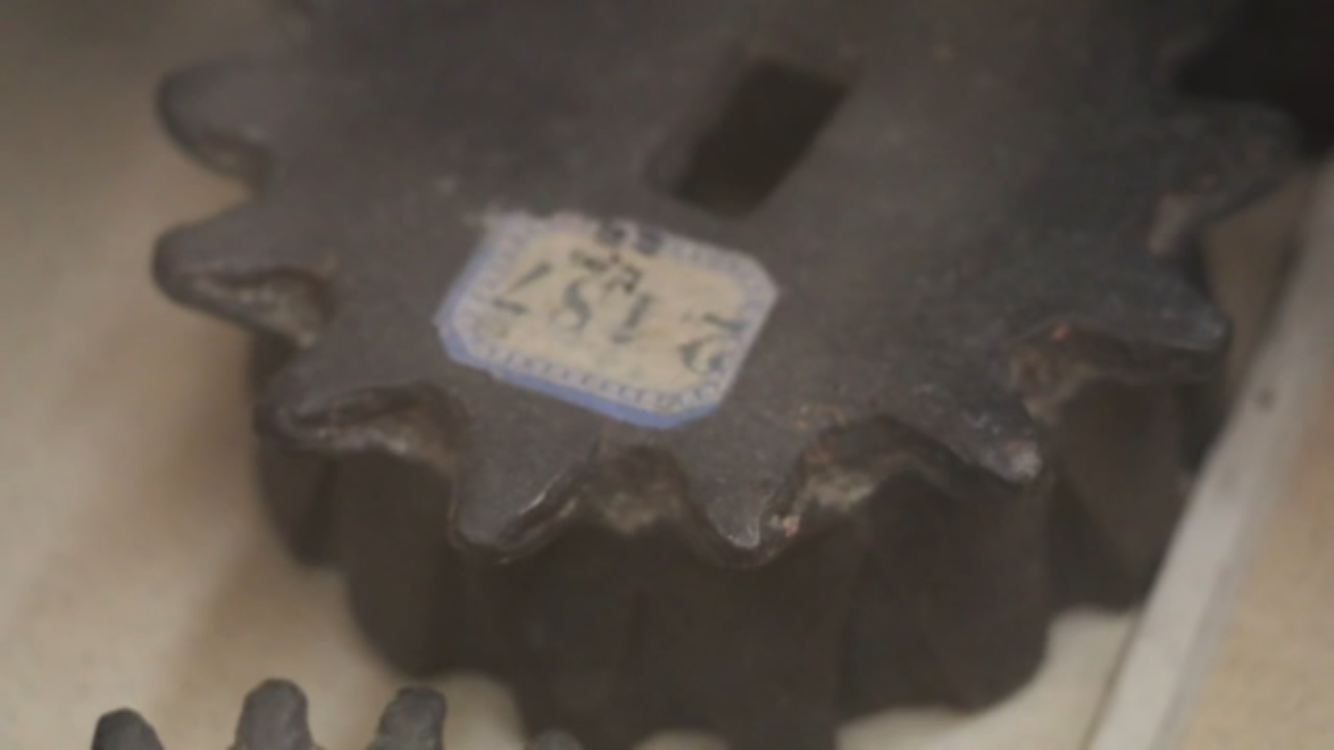
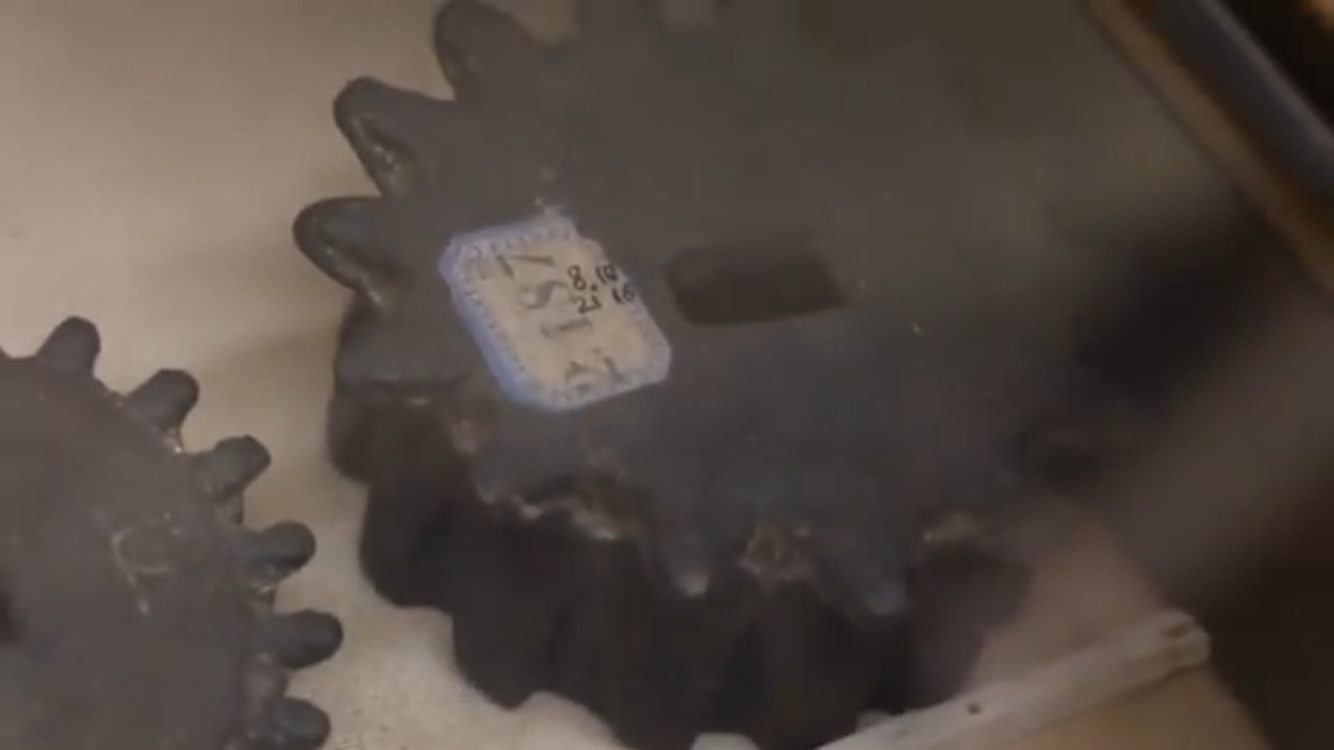
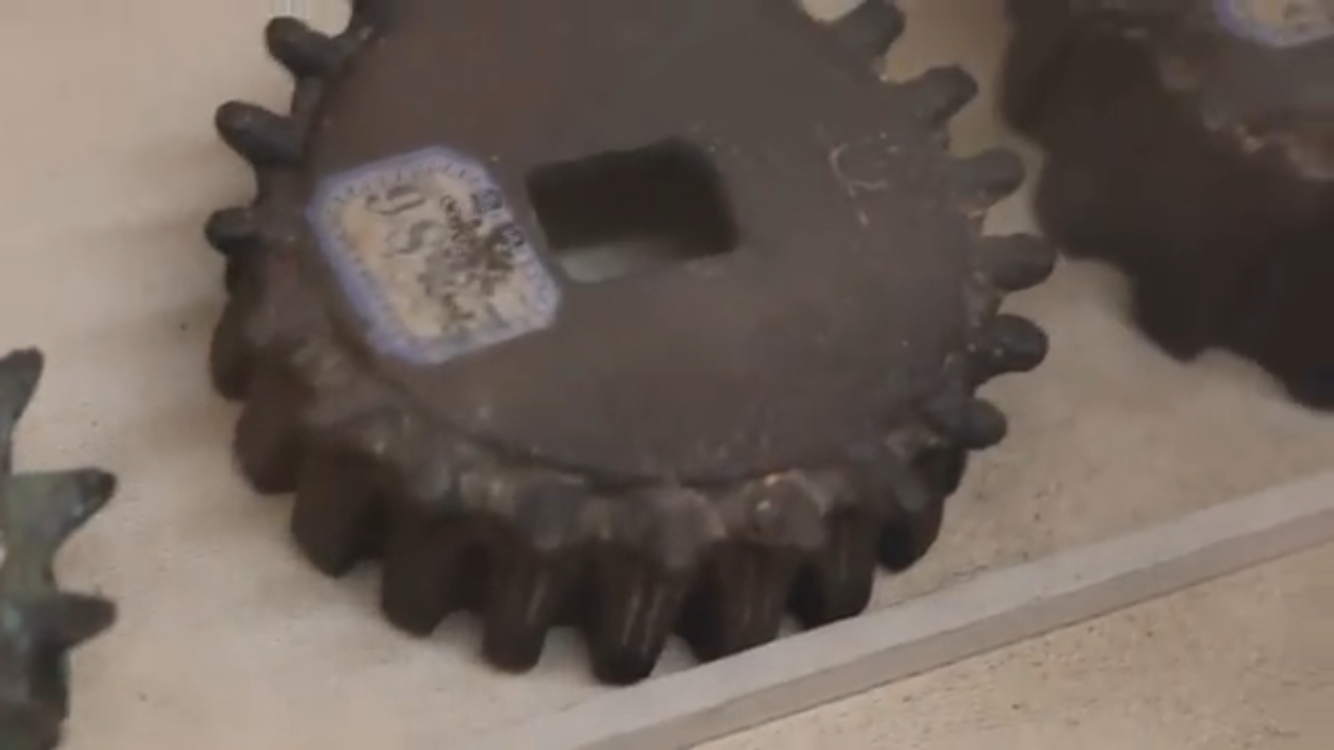
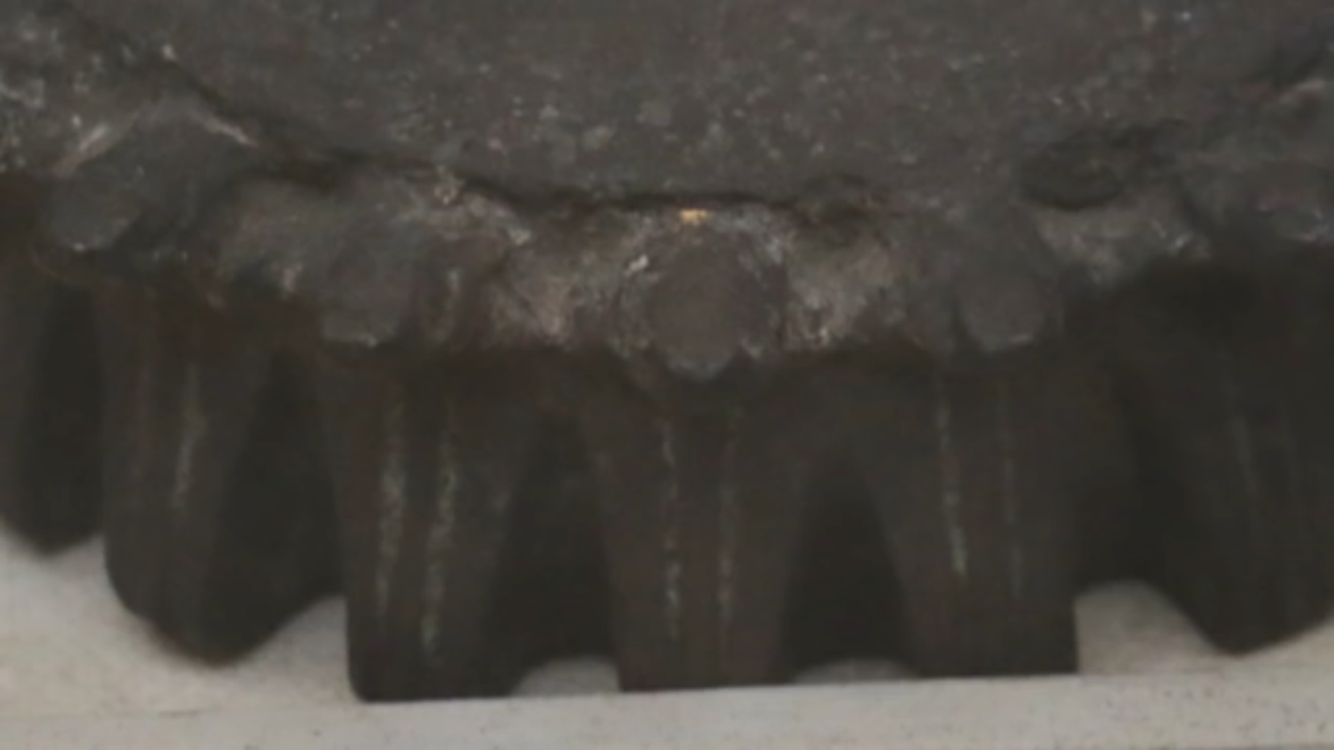
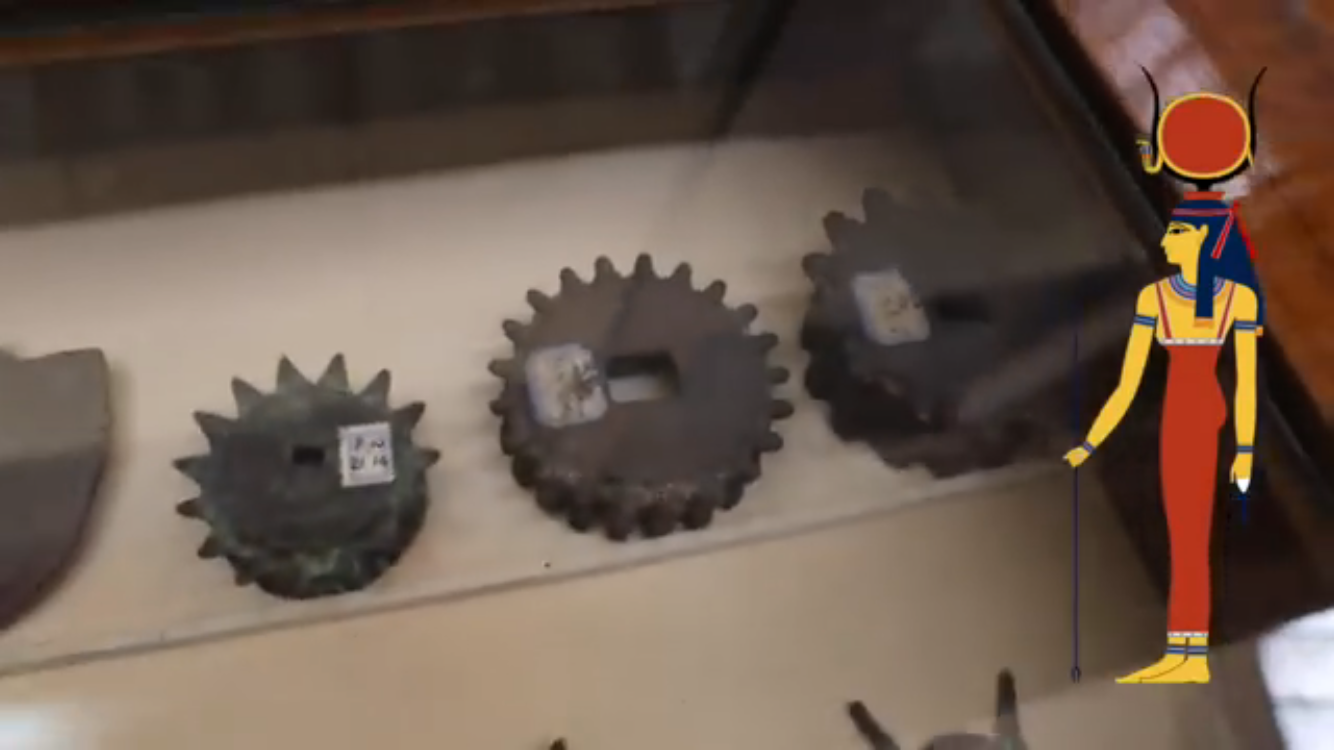
a reply to: Harte
I also agree that circular saws were not beyond their capability, humans have always come to the conclusion “ why don’t we just make a bigger one” so in my mind the AE certainly could have thought on this scale in a production sense.
There are no AE artwork of these objects but yet the evidence is there. Perhaps that’s why there were more of the stone boxes like on Elephantine Island, because they had the sawing capability to ‘knock them out’ as we say.
I’d really like to examine that stone of Dunn’s at Abu Ghirab and look at the striations it’s a fascinating piece to me.
This cut looks too clean on the surface to have had abrasives flying about between the blade and material.
How are you so sure you are not looking at feed rate?
In the machining world, these striations indicate a ‘power feed’ fingerprint. They are VERY regular, perhaps too regular for two guys with a copper saw and sand taking an absolute age at 3mm per day to hack through the piece.
They could surely have spun a circular blade at high rpm, the AE had gears didn’t they?
Cairo Museum :





a reply to: Harte
Ps- seeing as this thread originally started about the pyramids, the premise of what we’ve been talking about in the last few pages of this thread,
regarding stone cuttting, I think becomes even more relevant when we think of the huge granite pieces that are found inside the pyramid, the blocks
purportedly over 100 tonnes in wieght .
Are we still talking pounding and copper saws to extract these from a quarry? a reply to: Harte
Are we still talking pounding and copper saws to extract these from a quarry? a reply to: Harte
originally posted by: bluesfreak
The stone is found at Abu Rawash ( I mistakenly called it somewhere else in my last post!)
Which I believe is a 4th dynasty ruin . The piece is rose granite and is found on the south side of the pyramid ruin , about 100 m from its base.
a reply to: Hanslune
Disregard I found it
""Excellent do you an image of it in situ? I'm wondering if it was one of the pieces cut with modern tools when they were cleaning up the area for tourist visitations.""
www.gizapower.com...
edit on 18/11/18 by Hanslune because: (no reason given)
originally posted by: bluesfreak
Ps- seeing as this thread originally started about the pyramids, the premise of what we’ve been talking about in the last few pages of this thread, regarding stone cuttting, I think becomes even more relevant when we think of the huge granite pieces that are found inside the pyramid, the blocks purportedly over 100 tonnes in wieght .
Are we still talking pounding and copper saws to extract these from a quarry? a reply to: Harte
Yep
These slabs are very irregular because they weren't meant to ever be seen
edit on 18/11/18 by Hanslune because: (no reason given)
new topics
-
Nigel Farage : I am giving up control of the party to its members.
Regional Politics: 57 minutes ago -
I want Love!
Rant: 1 hours ago -
Aerospace’s Secret Search For Antigravity
Science & Technology: 2 hours ago -
Limits on Technology
Science & Technology: 3 hours ago -
20 Supporters Seated Behind Trump Onstage Rushed to Hospital
2024 Elections: 5 hours ago -
FBI says Iran sent hacked Trump info to Biden campaign
US Political Madness: 6 hours ago -
There would be no political madness, if We the People know the Truth
US Political Madness: 8 hours ago -
Gavin Newsom passes law against deepfake political ads
Politicians & People: 11 hours ago
top topics
-
20 Supporters Seated Behind Trump Onstage Rushed to Hospital
2024 Elections: 5 hours ago, 19 flags -
American Troops React to Kamala Harris Claim of No U.S. Troops in Combat Zones
Propaganda Mill: 17 hours ago, 11 flags -
FBI says Iran sent hacked Trump info to Biden campaign
US Political Madness: 6 hours ago, 11 flags -
New electoral college model, according to Nate Silver (no tossup).
2024 Elections: 16 hours ago, 11 flags -
There would be no political madness, if We the People know the Truth
US Political Madness: 8 hours ago, 8 flags -
Gavin Newsom passes law against deepfake political ads
Politicians & People: 11 hours ago, 7 flags -
Teamsters Has Announced It Will Not Endorse Any 2024 Presidential Candidate
2024 Elections: 17 hours ago, 7 flags -
Limits on Technology
Science & Technology: 3 hours ago, 6 flags -
I have Three Questions .
US Political Madness: 13 hours ago, 5 flags -
Aerospace’s Secret Search For Antigravity
Science & Technology: 2 hours ago, 2 flags
active topics
-
-@TH3WH17ERABB17- -Q- ---TIME TO SHOW THE WORLD--- -Part- --44--
Dissecting Disinformation • 2662 • : Thoughtful3 -
The UK collapsing fast
Science & Technology • 230 • : Oldcarpy2 -
FBI says Iran sent hacked Trump info to Biden campaign
US Political Madness • 29 • : Guyfriday -
20 Supporters Seated Behind Trump Onstage Rushed to Hospital
2024 Elections • 29 • : xuenchen -
Aerospace’s Secret Search For Antigravity
Science & Technology • 2 • : Oldcarpy2 -
Nigel Farage : I am giving up control of the party to its members.
Regional Politics • 5 • : angelchemuel -
Mood Music Part VI
Music • 3607 • : Hellmutt -
I have Three Questions .
US Political Madness • 19 • : xuenchen -
Ukraine hit 300 miles into Russia
World War Three • 81 • : Kurokage -
Cell phones exploding in Lebanon mass casualties
Middle East Issues • 63 • : LollieK3
